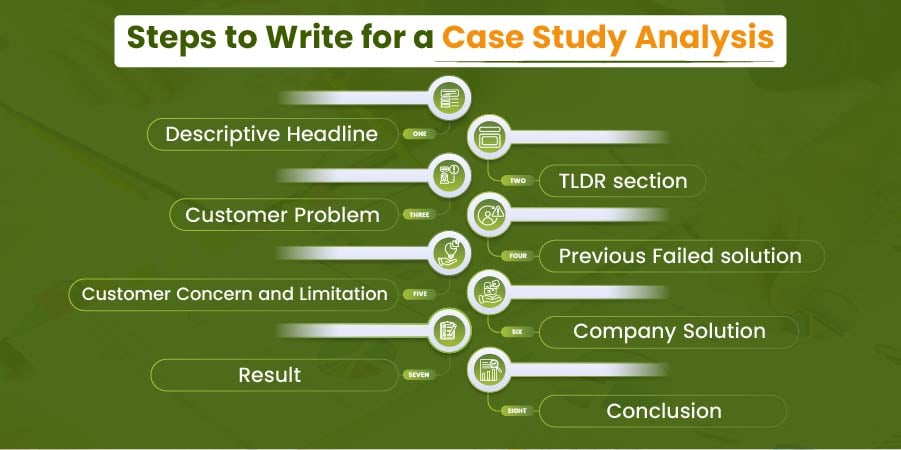 Offers
New
Order Now
Offers
New
Order Now
It is not an easy job to write a case study analysis, and it takes a lot of bravery and hard work to accomplish this feat. This method can be quite daunting for first-timers, and you might encounter many issues while handling such a topic. Generally, you write such a piece for your master's or PhD at a university.
Some of you might not be able to encompass all the details properly. It requires thorough research before you even put pen to paper. However, you are not alone in this dilemma, and further up ahead, we will tell you all about what a case study is, its types, composition and the step-by-step process you need to follow to analyse it.
The case study meaning is simple. It a process through which you investigate a particular event, person, situation, object or sometimes place. You conform to a set structure when you examine anything, as it makes your task easy to handle, and you can make changes according to your needs. Moreover, it has multiple genres, and you can pick and choose from either of the options. Let's learn about its different types.
Get A+ Grades NowThere are seven types of case studies in which you can examine a problem and come up with solutions and ideas on how to tackle it. They are as follows:
It is a descriptive study that depicts one or more occurrences in a specific event to describe a situation. Moreover, it tells you about a phenomenon, why it is happening, and its current position.
This study is designed to learn about a real-life event or occurrence. Once you know the reason behind it, you can take steps to change or alter the variables. Therefore, you might be able to control the outcome causing such an effect accordingly.
A data breakdown process that involves the sequential analysis of numerous issues over time to create a complete account of a certain phenomenon or issue. Moreover, it uses information from past studies about a group of people in a setting as its foundation.
This study commonly involves studying one or more sensations to interpret and concentrate on a single event instead of generalizing the situation.
It invites you to examine a specific occasion or problem to pinpoint the key facts. It also looks at what happened and who was/is involved. Moreover, it is also used to collate two instances of an occasion to display how one is identical to the other.
It is an analysis technique where the issue is of particular appeal rather than being preferred for its relevance to a larger theory or phenomenon. So, the intent is to deeply comprehend the special qualities, fineness, and intricacies of the matter under study.
An instrumental case study aspires to furnish insight into a problem or distil a view in which the issue itself is secondary and might be atypical of other subjects. In this type, you research an issue that facilitates understanding another event.
It is vital to know your case study outline, as it gives you a composition you must follow. So, let us look at it.
This part identifies the main section of your case study that you will examine. It typically includes a brief introduction, the problem, solutions, the research paper structure you implement, the result after applying solutions and finally, the takeaway from it.
Briefly mention the case studyto identify their importance. Mention the problem that you will solve with the approach that you will use. Hence, you must keep it simple and concise and only give information in a summary form.
You present data, charts, figures, and numbers that you have used to find the solution to the problem. You will use the research that you have done to prove your theory.
A good discussion is the study of any unexpected findings. You should discuss why such a finding has occurred and the impact it will have on the overall study of the subject matter.
You start by summarizing your entire study. Mention the arguments that you have stated inside. Moreover, you also state the evidence and case study research that you have used to prove your points.
In this section, you provide realistic solutions to solve the problem. You should also explain the positive and negative impact of the implementation of your solutions.
The reference section generally includes the author's name, document title, date, and source from which you took the information. So, all of these are vital to state in this part of the document.
It comes at the end of your document. It includes raw data or transcripts of interviews. The information in this section is vital, but it is too long to include in the main body of your work.

There are seven steps to follow to know how to write a case study analysis to have a comprehensive idea about the entire issue at hand. They are as follows:
Your headline should always give an idea about what your case study will entail. It might be the last problem that you tackle when you write your subject matter. However, it will be the first thing the reader will notice, so make it count.
Too long, did not read it. See it is the bane of existence of every writer. So, to solve this problem, mention in two to three sentences a synopsis of your entire matter and the arguments and evidence you took to prove your point.
This section depends on the length of the problem that the customer is facing. So, it can consist of one paragraph or several pages, depending on the task. You will also mention why it was vital to solve this problem and its impact on the customer's business.
If your customer has applied some solutions before approaching you, you must also mention them. It is up to you to mention the names of the solutions that did not work. However, if you do, it will help to highlight the methods that you have imposed that helped your customer.
If your customer gave you strict guidelines to follow while providing a solution to the problem, then you must also mention it. Moreover, it will help other people facing the same roadblocks and will automatically benefit you.
Mention the solution you gave to the customer while also keeping in mind the limitations put on you. You can also state if you exceeded the customer's expectations and made them happy. Give all the steps you took, and do not miss out on any point.
The last part is to state the result of your case study topics that you achieved by application of your solution. You can describe whether the customer was happy with the outcome and can also quote him in the process.
Sometimes, the result section is inadequate when your case study is lengthy. Therefore, you can mention the conclusion that encompasses major takeaways and incorporate a last quote and relevant call to action(CTA), if applicable.
Complete Your Task QuicklyIt is easy to understand something when you give a case study examples. It helps to clear the matter at hand.
Case Study Example Topic: Study on Consumption of Pepsi on Youths' Health
Introduction
This case study is about the impact of cold drinks on the health of today's youth. So, we will focus on the negative benefits it has like obesity, high blood pressure, and increased insulin levels in the younger generation.
Customer Problem
The problem that youngsters face these days is:
Company Solution
A survey of 1000 children from ages 12-22 will gather information on the effects of Pepsi on youth's health. It will show the correlation between consumption and health. It will also aid in.........
So, this is an example of a case study analysis. If you follow this blog, you will gather the information about the case study structure you need to heed for thorough knowledge. But if you still need further information, you can get the best aid from our experts.
Therefore, you saw what a case study analysis is, its types and the step-by-step procedure that you need to follow. To attract a reader towards you, you need to make sure that you follow all the requirements. Many of you face problems in figuring out what you need to put in your piece.
You can reach out to us for a better understanding of the nuances of this subject matter. We at our disposal have many professionals and experts who can help you with your tasks, answer queries and deliver them on time. You can check out our sample to see the writing quality of our experts. You can also use a plagiarism checker, or paraphrasing tool to improve your piece.
You May Also Like To Read :
200+ Most Funny Speech Topics to Make You Laugh!
How to Detect AI-Written Text? | Top Techniques & Importance
Steps to Create a Clear and Effective Research Paper
Learn How to Write a Business Report

Grab this exclusive offer and start your journey to savings today! Act quickly, as this special offer won't be around for long!

This blog explains what is a hyperbole, provides engaging examples, & explores how to use hyperbole.

Explore 150+ funny debate topics to spark laughter, creativity, and lively discussions in 2025

Cross-Sectional Study basics explained with steps, examples, and comparisons.
Limited Time Offer
Exclusive Library Membership + FREE Wallet Balance
1 Month Access !
5000 Student Samples
+10,000 Answers by Experts
Get $300 Now
Update your Number

